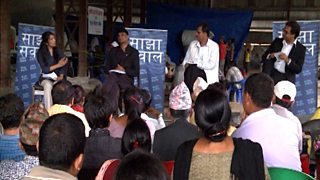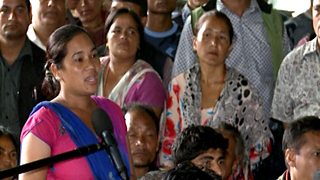Bringing hope after disaster in Nepal
Bidhya Chapagain
Presenter

Man Bahadur Lama was sitting in a relief centre when I first met him. Visibly shocked and heavy with grief, he told me he was desperately awaiting government papers which would qualify him for help as a person displaced by disaster.
We were at the makeshift centre - a vast hall in a disused mining plant in the Sindupalchowk district of Nepal - to record an episode of our TV and radio debate show Sajha Sawal (Common Questions).
Two days before, on 2 August, killing more than 170 people as it swept away villages and homes.
Man Bahadur told me how he had survived: “I was away working on a night shift. When I came back the next day after speaking to my sister, I saw nothing there but the landslide. I lost both of my sons, my wife, my mother and my house.”
A community in shock
Everyone I spoke to in the shelter had lost relatives, their home or both. Thousands more downstream had fled their homes for higher ground because the landslide had blocked the river, creating a temporary dam which threatened to burst. Power had also been cut off when floodwaters submerged a small hydropower project.
A study carried out eight years ago by the Nepali government’s Department of Geology showed that there was a high risk of landslides in the region. And it’s a common story across the country: Nepal is highly vulnerable to landslides and flooding, particularly during the monsoon season between June and August.

Getting their voices heard
As we converted the hall into a makeshift studio and prepared to start recording, I couldn’t help wondering whether this disaster could have been avoided. Could anything have been done to reduce the risks and save lives? It was a question our audience in the hall asked again and again – and it was also clear they wanted to ensure they could rebuild their lives in the best way to withstand such disasters in the future.
One of the panellists whom we had invited on to the show was the government representative of the Disaster Management Division, Yadav Koirala. He admitted, “We have not done proper country-wide hazard mapping. Only a few sensitive places have been marked, and there is no clear policy to help us implement activities to minimise such risks.”
Another panellist, geologist Ranjan Kumar Dahal, blamed politicians for not acting quickly enough. “It is because of political personnel, who haven’t provided us with a law in time, that people like me are not being able to get to work [to improve the situation].”
He called for a Disaster Management Act to be brought into force, which, he said, should dictate where it is safe for people to build houses, as well as laying down evacuation and relief plans to follow in emergencies. If such a system had been in place, he said, the dam could have been cleared in a matter of hours and not threatened people downstream.

A local resident, Amrita Nepal, took the chance to question the panellists from the audience about the level of relief provided to survivors.
She said, “After the disaster, the �������� Minister said that he will not leave any stones unturned to provide relief to the victims of the landslide. Does the government feel that it has fulfilled its responsibilities by distributing 5000 to 40,000 Rupees (approximately £30 to £250) and a couple of sacks of rice to the displaced families of those who lost their lives in the disaster?”
A third panel member, the Constituent Assembly Member for the district and former Minister for Communications, Agni Sapkota replied, “I am aware of how important laws are. I shall first commit to ensure that the orphaned children and senior citizens find guardians, [that] electricity, telephone services and road network are re-established, and that people get supplies like wood to rebuild their houses and fertilizers for their farms. I shall start [this process] and demand that the whole parliament should put such policies and rules in place.”
It was an important commitment – and one that we’ll regularly follow up and hold them to on Sajha Sawal.
In the meantime I won’t forget what I saw in Sindupalchowk – the tragedy, the humanity and people’s amazing resilience. As well as hearing terrible stories of loss, I also witnessed how survivors were already making every effort to rebuild their lives – in addition to the efforts of the army, non-governmental organisations and individuals who provided relief to the survivors.
Related links
Follow �������� Media Action on and
